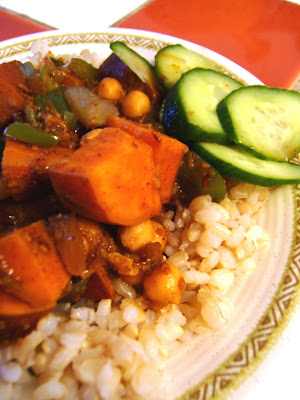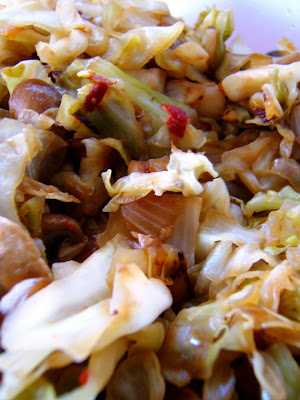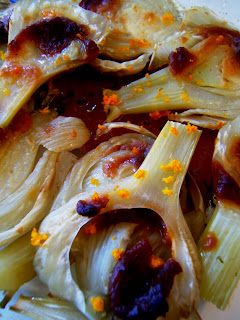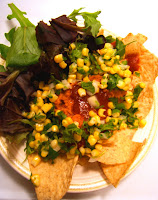 Life these days is busy, but good. I thought this evening, Ah, to drink a Mexican beer on a rooftop in Little Armenia, watching the sun set to the west of the Hills, and prepare half of a lecture on Keats... not bad! And then to go inside and make my own curry powder! Well, I'm into it, anyway.
Life these days is busy, but good. I thought this evening, Ah, to drink a Mexican beer on a rooftop in Little Armenia, watching the sun set to the west of the Hills, and prepare half of a lecture on Keats... not bad! And then to go inside and make my own curry powder! Well, I'm into it, anyway.I'd had some sweet potatoes in my kitchen begging me to use them before they go bad for over a week now. Also, I recently acquired half a pound of fennel seed at Jon's for $3. Also, I found this recipe on the internet. Forces conspired, let's say, to bring this recipe to my stomach and this blog.
Alterations to recipe
I'm not sure how much oil I ended up using. 2 TB seemed like a lot, but the sheer amount of spices necessitated that I add more as I went along. Also, the original didn't actually specify how much sweet potato to use. Then, I unwittingly used 1 cup rather than 1 can coconut milk, and it was "light"--this was totally fine (especially since I went out for Thai food last night and probably consumed 1/4 c of oil in my delicious fried eggplants). I also used extra chickpeas: if a small can is just over the requisite 1 c, why not just dump it all in? Finally, following my friend Sowjanya's suggestion to add coconut to more savory dishes, I also put in some shredded unsweetened coconut, which added more texture as well as flavor.
As for flavors, I used a particular curry powder (recipe below), and I'm sure that different ones would produce different results. I also added the better part of a large chili pepper (labeled pasilla but perhaps a poblano?), and this made it just a bit spicy. Then, I didn't have any tamarind--a key ingredient!--so I approximated it by using pomegranate molasses. Finally, perhaps because the chickpeas I used come in brine, I used half the salt, and it was fine.
Assessment
When I put the ground spices in the frying pan, I was worried that the spices, especially the 2 TB (!) fennel, would be too overpowering. But in the final analysis, when watered down by sweet potato, coconut milk, and accompanying rice, they're just right. Warm, almost buttery, and so interesting! My guess is that the overall dish depends heavily on what's in the "curry powder" you use: the recipe I got from the Bittman bible uses a lot of cinnamon and cloves, which shine out quite a lot when paired with sugar as they are here. I'd love someone's best guess as to what the make up of the ubiquitous "curry" flavor is--it's quite a bit different than the recipe at the bottom of this post.
Anyway, if I were to change anything about this dish, I'd like less sweetness and more sourness--I thought that the pomegranate molasses would do the trick, but I think it would have needed more acid (i.e., lemon) and less sugar (i.e., pomegranate juice).
The textures are lovely: slightly crunchy bell pepper, firm but soft sweet potatoes and chickpeas, and a sauce that is rich but not at all oily (its thickness derives as much from the quantity of spices as it does from the cup of coconut milk). You probably want to watch out that the potatoes and peppers don't get overcooked.
Tangy Sweet Potato Curry
(adapted from kirsten's kitchen)
Ingredients
2 TB vegetable oil
1 onion, chipped
3 cloves garlic, minced
1 TB fresh ginger, minced
1 TB cumin powder
1 TB paprika
1 TB curry powder (recipe below)
1/4 tsp allspice
2 TB fennel seeds- toasted and crushed
3 small sweet potatoes/yams, 1/2-to-1-in dice
1 c coconut milk
1 c water
1/4 c pomegranate molasses thinned with water OR 3 TB tamarind paste soaked in 1/4 c water
1+ cup cooked chickpeas
1 onion, chipped
3 cloves garlic, minced
1 TB fresh ginger, minced
1 TB cumin powder
1 TB paprika
1 TB curry powder (recipe below)
1/4 tsp allspice
2 TB fennel seeds- toasted and crushed
3 small sweet potatoes/yams, 1/2-to-1-in dice
1 c coconut milk
1 c water
1/4 c pomegranate molasses thinned with water OR 3 TB tamarind paste soaked in 1/4 c water
1+ cup cooked chickpeas
1/4 c unsweetened shredded coconut
1 green pepper, chopped
1/2 large green chili (pasilla or poblano), diced
2 tsp cane sugar, to taste
1-2 tsp sea salt, to taste
freshly ground pepper or cayenne, to taste
cucumbers for garnish
1 green pepper, chopped
1/2 large green chili (pasilla or poblano), diced
2 tsp cane sugar, to taste
1-2 tsp sea salt, to taste
freshly ground pepper or cayenne, to taste
cucumbers for garnish
Instructions
In a large skillet, heat oil on medium high heat. Add onions and saute for 3-4 minutes until soft. Add garlic and ginger, stir, then add spices and stir around until no longer powdery. Add potato, stir to cover with spices. Add coconut milk and water. Bring to a boil. Add both peppers and coconut, and let simmer for 5 minutes. Add chickpeas and pomegranate molasses (or tamarind liquid). Season with sugar,salt and pepper. Serve with rice, and garnish with sliced cucumber. Serves at least 4.
*
Curry Powder
(adapted from How to Cook Everything Vegetarian's "Fragrant Curry Powder")
Ingredients
1/4 tsp nutmeg powder
5 cardamom pods, outsides removed
3 whole cloves
1 3-in cinnamon stick
1 tsp black peppercorns
2 TB cumin seeds
1/4 c coriander seeds
2 bay leaves
1 tsp ground turmeric
Instructions
In a cast iron skillet or toaster oven, toast all the spices except the turmeric, stirring occasionally, until fragrant and slightly browned. Allow to cool slightly before grinding and mixing in turmeric. Makes a lot (1/4 c?).






















